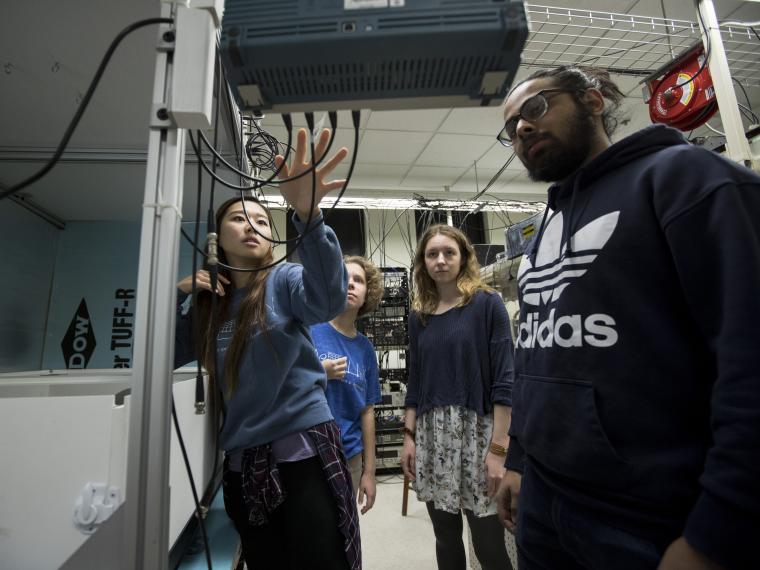No Ordinary Matter: Professor of Physics Jason Stalnaker is Part of Global Effort Testing for Dark Matter
September 7, 2022
Amanda Nagy

Professor of Physics Jason Stalnaker is part of a worldwide network of scientists searching for evidence of dark matter fields using magnetometers based on alkali atoms.
Stalnaker’s lab is one of only three undergraduate-only institutions collaborating in the Global Network of Optical Magnetometers for Exotic Physics Searches, or GNOME. The researchers are coordinating experiments with the goal of detecting and collecting data on dark matter—a hypothetical mass that doesn’t emit light but makes up the majority of the universe.
Physicists have long known that dark matter exists because of the effect it has on astronomical observations. For instance, it can explain the way stars in a galaxy spin around the center. Dark matter is named so because it is composed of particles that do not absorb, reflect, or emit light.
“We have a pretty good understanding of ordinary matter, but if we look out in the universe and we look at the way stars move in galaxies, we see that apparently 80 percent of a matter out there is not made up of the matter that we know of and are familiar with,” says Stalnaker. “It's something that is not basic atoms made up from quarks and electrons. It doesn't interact with or emit light, and we don't see light scattering off of it. We don’t know exactly what it is at this point.”
Looking for signals
Scientists working on the project believe that dark matter fields should produce a signal pattern that can be detected by magnetometers at multiple stations of the GNOME network distributed around the world, including Germany, Serbia, Poland, Israel, South Korea, China, Australia, and several labs in the United States.
“The question is, how do you detect dark matter? One possibility is that the interaction between dark matter and ordinary matter might act like a magnetic field,” explains Stalnaker, whose research is funded by a three-year grant from the National Science Foundation. One candidate for dark matter is that it can take the form of a large-scale cosmological structure known as a domain wall.
Stalnaker has expertise in building atomic magnetometers—instruments that can measure very small magnetic fields. By spreading the magnetometers across the world, researchers can stream data at the same time and look for correlations between locations. If the Earth passes through some very large structure, the hope is that it will be detected by the GNOME network and produce a signal pattern—a sign of a global dark matter interaction.
An article published in Nature Physics in late 2021 includes three Oberlin undergraduates as coauthors: Sun Yool Park '19, Perrin Segura '20, and Dhruv Tandon '22. All three participated in the honors program in physics and did their research on some aspect of the GNOME project. Stalnaker says the article was an important milestone for the collaboration, as it reports the first limits the GNOME network has placed on a potential dark-matter candidate.
Mentoring future physicists
At Oberlin, Stalnaker and his student collaborators are leading a different analysis designed to look for dark matter in the form of axion stars. These axion stars would be large-scale clusters of dark matter particles. Segura and Tandon both worked on this effort for their honors theses.
“This is a great project for students because they have been able to take control of the analysis, and they get to do really cool things,” Stalnaker says, noting that his former students graduated with highest honors and are now working toward graduate programs in physics. Stalnaker’s students also have opportunities to present their data at conferences and GNOME collaboration meetings.
Park, a PhD student at the University of Colorado at Boulder, was the lead student in the construction of the first generation of the magnetometer. “She was the driving force behind getting it up and running. It’s really quite impressive,” says Stalnaker.
Segura, a PhD student at Harvard, did her honors thesis on developing an algorithm to look for a dark matter candidate. In 2019, she accompanied Stalnaker to a GNOME collaboration meeting in Germany, where she presented on her data analysis routine.
Ehsan Nikfar is a rising sophomore who is working on the axionstar analysis, and Eduardo Castro Muñoz, a rising senior, is working on a project related to GNOME, the Search for Non-Interacting Photon Experiment (SNIPE).
Nikfar, an international student from Herat, Afghanistan, joined Stalnaker’s lab as a scholar in Oberlin’s STRONG program (Science and Technology Research Opportunities for a New Generation), which provides early research opportunities with faculty mentors. Nikfar says that collaborating with his faculty mentor has given him experience in solving real-world problems.
“At first, it was very challenging for me to do research because I lacked a plethora of skills,” says Nikfar, a computer science and physics double major. “Professor Stalnaker was very supportive in my first year and patiently taught me the necessary skills.”
Castro Muñoz, a physics and Hispanic studies major from Copiapó, Chile, says his work on the dark matter experiments and data analysis has made him a better computer programmer.
“I’ve fallen in love with physics. After graduating from Oberlin, I want to join a PhD program and keep learning about physics,” Castro Muñoz says.
Scientific research isn’t a solitary pursuit, and the investment in training young scientists is mutually beneficial for faculty and students.
Stalnaker says the nature of dark matter is one of the most important questions in fundamental physics, and “it has been exciting to work on figuring it out with Oberlin undergraduate students.”
SNIPEs and Where to Find Them
Rising fourth-year physics major Eduardo Castro Munoz and his mentor, Oberlin professor Jason Stalnaker, conducted summer research intended to shed light on a little-known facet of our universe. Along with fellow physics student Ehsan Nikfar, they took to the woods to capture information about dark photons, which could provide evidence supporting the existence of dark matter. All of which helps explain the study’s playful acronym: the Search for Non-Interacting Photons Experiment, or SNIPE.
Tags:
You may also like…
Oberlin Summer Research Institute Partners with Career Exploration and Development, Expands Capacity
January 17, 2025
For almost 20 years, Oberlin Summer Research Institute, or OSRI, has been fostering community and the development of Oberlin students. Now, beginning in summer 2025, the program will offer exciting new opportunities.
Ava Harvey ’26 Earns Leadership Alliance Summer Research Fellowship
August 8, 2024
Ava Harvey ’26 received a Summer Research Early Identification Program (SR-EIP) Fellowship from the Leadership Alliance.
Freya Kailing ’25 Named 2024 Goldwater Scholar
August 7, 2024
Freya Kailing ’25, a biology major from Kalamazoo, Michigan, received a 2024 Goldwater Scholarship, a prestigious award for college students planning research careers.


